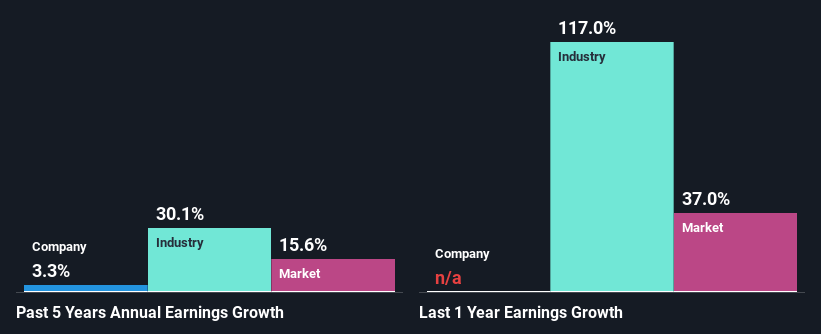Does The Market Have A Low Tolerance For First Quantum Minerals Ltd.'s (TSE:FM) Mixed Fundamentals?
With its stock down 7.1% over the past month, it is easy to disregard First Quantum Minerals (TSE:FM). It is possible that the markets have ignored the company's differing financials and decided to lean-in to the negative sentiment. Fundamentals usually dictate market outcomes so it makes sense to study the company's financials. In this article, we decided to focus on First Quantum Minerals' ROE.
Return on Equity or ROE is a test of how effectively a company is growing its value and managing investors’ money. Simply put, it is used to assess the profitability of a company in relation to its equity capital.
View our latest analysis for First Quantum Minerals
How Is ROE Calculated?
ROE can be calculated by using the formula:
Return on Equity = Net Profit (from continuing operations) ÷ Shareholders' Equity
So, based on the above formula, the ROE for First Quantum Minerals is:
7.3% = US$813m ÷ US$11b (Based on the trailing twelve months to September 2021).
The 'return' is the profit over the last twelve months. That means that for every CA$1 worth of shareholders' equity, the company generated CA$0.07 in profit.
Why Is ROE Important For Earnings Growth?
We have already established that ROE serves as an efficient profit-generating gauge for a company's future earnings. Based on how much of its profits the company chooses to reinvest or "retain", we are then able to evaluate a company's future ability to generate profits. Assuming all else is equal, companies that have both a higher return on equity and higher profit retention are usually the ones that have a higher growth rate when compared to companies that don't have the same features.
A Side By Side comparison of First Quantum Minerals' Earnings Growth And 7.3% ROE
When you first look at it, First Quantum Minerals' ROE doesn't look that attractive. Next, when compared to the average industry ROE of 14%, the company's ROE leaves us feeling even less enthusiastic. Thus, the low net income growth of 3.3% seen by First Quantum Minerals over the past five years could probably be the result of the low ROE.
As a next step, we compared First Quantum Minerals' net income growth with the industry and were disappointed to see that the company's growth is lower than the industry average growth of 30% in the same period.
The basis for attaching value to a company is, to a great extent, tied to its earnings growth. What investors need to determine next is if the expected earnings growth, or the lack of it, is already built into the share price. This then helps them determine if the stock is placed for a bright or bleak future. One good indicator of expected earnings growth is the P/E ratio which determines the price the market is willing to pay for a stock based on its earnings prospects. So, you may want to check if First Quantum Minerals is trading on a high P/E or a low P/E, relative to its industry.
Is First Quantum Minerals Efficiently Re-investing Its Profits?
A low three-year median payout ratio of 1.1% (implying that the company retains the remaining 99% of its income) suggests that First Quantum Minerals is retaining most of its profits. However, the low earnings growth number doesn't reflect this as high growth usually follows high profit retention. Therefore, there might be some other reasons to explain the lack in that respect. For example, the business could be in decline.
Additionally, First Quantum Minerals has paid dividends over a period of at least ten years, which means that the company's management is determined to pay dividends even if it means little to no earnings growth. Our latest analyst data shows that the future payout ratio of the company over the next three years is expected to be approximately 1.3%. However, First Quantum Minerals' ROE is predicted to rise to 13% despite there being no anticipated change in its payout ratio.
Summary
On the whole, we feel that the performance shown by First Quantum Minerals can be open to many interpretations. Even though it appears to be retaining most of its profits, given the low ROE, investors may not be benefitting from all that reinvestment after all. The low earnings growth suggests our theory correct. With that said, the latest industry analyst forecasts reveal that the company's earnings are expected to accelerate. To know more about the latest analysts predictions for the company, check out this visualization of analyst forecasts for the company.
Have feedback on this article? Concerned about the content? Get in touch with us directly. Alternatively, email editorial-team (at) simplywallst.com.
This article by Simply Wall St is general in nature. We provide commentary based on historical data and analyst forecasts only using an unbiased methodology and our articles are not intended to be financial advice. It does not constitute a recommendation to buy or sell any stock, and does not take account of your objectives, or your financial situation. We aim to bring you long-term focused analysis driven by fundamental data. Note that our analysis may not factor in the latest price-sensitive company announcements or qualitative material. Simply Wall St has no position in any stocks mentioned.

 Yahoo Finance
Yahoo Finance 
